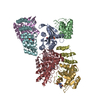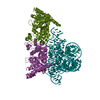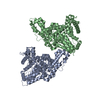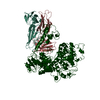[English] 日本語
 Yorodumi
Yorodumi- EMDB-31145: Cryo-EM structure of the type 1 bradykinin receptor in complex wi... -
+ Open data
Open data
- Basic information
Basic information
| Entry | Database: EMDB / ID: EMD-31145 | |||||||||||||||||||||
|---|---|---|---|---|---|---|---|---|---|---|---|---|---|---|---|---|---|---|---|---|---|---|
| Title | Cryo-EM structure of the type 1 bradykinin receptor in complex with the des-Arg10-kallidin and an Gq protein | |||||||||||||||||||||
 Map data Map data | ||||||||||||||||||||||
 Sample Sample |
| |||||||||||||||||||||
 Keywords Keywords | Bradykinin receptors / Kinin / GPCR / MEMBRANE PROTEIN | |||||||||||||||||||||
| Function / homology |  Function and homology information Function and homology informationbradykinin receptor activity / G-protein activation / Activation of the phototransduction cascade / Glucagon-type ligand receptors / Thromboxane signalling through TP receptor / Sensory perception of sweet, bitter, and umami (glutamate) taste / G beta:gamma signalling through PI3Kgamma / G beta:gamma signalling through CDC42 / Cooperation of PDCL (PhLP1) and TRiC/CCT in G-protein beta folding / Activation of G protein gated Potassium channels ...bradykinin receptor activity / G-protein activation / Activation of the phototransduction cascade / Glucagon-type ligand receptors / Thromboxane signalling through TP receptor / Sensory perception of sweet, bitter, and umami (glutamate) taste / G beta:gamma signalling through PI3Kgamma / G beta:gamma signalling through CDC42 / Cooperation of PDCL (PhLP1) and TRiC/CCT in G-protein beta folding / Activation of G protein gated Potassium channels / Inhibition of voltage gated Ca2+ channels via Gbeta/gamma subunits / Ca2+ pathway / G alpha (z) signalling events / High laminar flow shear stress activates signaling by PIEZO1 and PECAM1:CDH5:KDR in endothelial cells / Glucagon-like Peptide-1 (GLP1) regulates insulin secretion / Vasopressin regulates renal water homeostasis via Aquaporins / Adrenaline,noradrenaline inhibits insulin secretion / ADP signalling through P2Y purinoceptor 12 / G alpha (q) signalling events / positive regulation of leukocyte migration / G alpha (i) signalling events / Thrombin signalling through proteinase activated receptors (PARs) / Activation of G protein gated Potassium channels / G-protein activation / G beta:gamma signalling through PI3Kgamma / Prostacyclin signalling through prostacyclin receptor / G beta:gamma signalling through PLC beta / ADP signalling through P2Y purinoceptor 1 / Thromboxane signalling through TP receptor / Presynaptic function of Kainate receptors / G beta:gamma signalling through CDC42 / Inhibition of voltage gated Ca2+ channels via Gbeta/gamma subunits / G alpha (12/13) signalling events / Glucagon-type ligand receptors / G beta:gamma signalling through BTK / ADP signalling through P2Y purinoceptor 12 / Adrenaline,noradrenaline inhibits insulin secretion / Cooperation of PDCL (PhLP1) and TRiC/CCT in G-protein beta folding / Ca2+ pathway / Thrombin signalling through proteinase activated receptors (PARs) / G alpha (z) signalling events / Extra-nuclear estrogen signaling / photoreceptor outer segment membrane / G alpha (s) signalling events / G alpha (q) signalling events / spectrin binding / G alpha (i) signalling events / Glucagon-like Peptide-1 (GLP1) regulates insulin secretion / High laminar flow shear stress activates signaling by PIEZO1 and PECAM1:CDH5:KDR in endothelial cells / Vasopressin regulates renal water homeostasis via Aquaporins / alkylglycerophosphoethanolamine phosphodiesterase activity / photoreceptor outer segment / response to mechanical stimulus / negative regulation of blood pressure / cardiac muscle cell apoptotic process / photoreceptor inner segment / peptide binding / Peptide ligand-binding receptors / positive regulation of release of sequestered calcium ion into cytosol / negative regulation of cell growth / cellular response to catecholamine stimulus / cell migration / adenylate cyclase-activating dopamine receptor signaling pathway / G-protein beta-subunit binding / cellular response to prostaglandin E stimulus / heterotrimeric G-protein complex / sensory perception of taste / signaling receptor complex adaptor activity / positive regulation of cytosolic calcium ion concentration / retina development in camera-type eye / cell body / GTPase binding / G alpha (i) signalling events / response to lipopolysaccharide / cellular response to hypoxia / phospholipase C-activating G protein-coupled receptor signaling pathway / G alpha (q) signalling events / cell population proliferation / G protein-coupled receptor signaling pathway / inflammatory response / GTPase activity / synapse / dendrite / protein-containing complex binding / endoplasmic reticulum / membrane / plasma membrane / cytoplasm Similarity search - Function | |||||||||||||||||||||
| Biological species |  Homo sapiens (human) / Homo sapiens (human) /   | |||||||||||||||||||||
| Method | single particle reconstruction / cryo EM / Resolution: 3.0 Å | |||||||||||||||||||||
 Authors Authors | Yin Y / Jiang Y | |||||||||||||||||||||
| Funding support |  China, 6 items China, 6 items
| |||||||||||||||||||||
 Citation Citation |  Journal: Nat Struct Mol Biol / Year: 2021 Journal: Nat Struct Mol Biol / Year: 2021Title: Molecular basis for kinin selectivity and activation of the human bradykinin receptors. Authors: Yu-Ling Yin / Chenyu Ye / Fulai Zhou / Jia Wang / Dehua Yang / Wanchao Yin / Ming-Wei Wang / H Eric Xu / Yi Jiang /  Abstract: Bradykinin and kallidin are endogenous kinin peptide hormones that belong to the kallikrein-kinin system and are essential to the regulation of blood pressure, inflammation, coagulation and pain ...Bradykinin and kallidin are endogenous kinin peptide hormones that belong to the kallikrein-kinin system and are essential to the regulation of blood pressure, inflammation, coagulation and pain control. Des-Arg-kallidin, the carboxy-terminal des-Arg metabolite of kallidin, and bradykinin selectively activate two G protein-coupled receptors, type 1 and type 2 bradykinin receptors (B1R and B2R), respectively. The hyperactivation of bradykinin receptors, termed 'bradykinin storm', is associated with pulmonary edema in COVID-19 patients, suggesting that bradykinin receptors are important targets for COVID-19 intervention. Here we report two G protein-coupled complex structures of human B1R and B2R bound to des-Arg-kallidin and bradykinin, respectively. Combined with functional analysis, our structures reveal the mechanism of ligand selectivity and specific activation of the bradykinin receptor. These findings also provide a framework for guiding drug design targeting bradykinin receptors for the treatment of inflammation, cardiovascular disorders and COVID-19. | |||||||||||||||||||||
| History |
|
- Structure visualization
Structure visualization
| Movie |
 Movie viewer Movie viewer |
|---|---|
| Structure viewer | EM map:  SurfView SurfView Molmil Molmil Jmol/JSmol Jmol/JSmol |
| Supplemental images |
- Downloads & links
Downloads & links
-EMDB archive
| Map data |  emd_31145.map.gz emd_31145.map.gz | 26.4 MB |  EMDB map data format EMDB map data format | |
|---|---|---|---|---|
| Header (meta data) |  emd-31145-v30.xml emd-31145-v30.xml emd-31145.xml emd-31145.xml | 19.7 KB 19.7 KB | Display Display |  EMDB header EMDB header |
| Images |  emd_31145.png emd_31145.png | 57.1 KB | ||
| Filedesc metadata |  emd-31145.cif.gz emd-31145.cif.gz | 6.8 KB | ||
| Archive directory |  http://ftp.pdbj.org/pub/emdb/structures/EMD-31145 http://ftp.pdbj.org/pub/emdb/structures/EMD-31145 ftp://ftp.pdbj.org/pub/emdb/structures/EMD-31145 ftp://ftp.pdbj.org/pub/emdb/structures/EMD-31145 | HTTPS FTP |
-Related structure data
| Related structure data |  7eibMC  7f2oC M: atomic model generated by this map C: citing same article ( |
|---|---|
| Similar structure data |
- Links
Links
| EMDB pages |  EMDB (EBI/PDBe) / EMDB (EBI/PDBe) /  EMDataResource EMDataResource |
|---|---|
| Related items in Molecule of the Month |
- Map
Map
| File |  Download / File: emd_31145.map.gz / Format: CCP4 / Size: 30.5 MB / Type: IMAGE STORED AS FLOATING POINT NUMBER (4 BYTES) Download / File: emd_31145.map.gz / Format: CCP4 / Size: 30.5 MB / Type: IMAGE STORED AS FLOATING POINT NUMBER (4 BYTES) | ||||||||||||||||||||||||||||||||||||||||||||||||||||||||||||
|---|---|---|---|---|---|---|---|---|---|---|---|---|---|---|---|---|---|---|---|---|---|---|---|---|---|---|---|---|---|---|---|---|---|---|---|---|---|---|---|---|---|---|---|---|---|---|---|---|---|---|---|---|---|---|---|---|---|---|---|---|---|
| Projections & slices | Image control
Images are generated by Spider. | ||||||||||||||||||||||||||||||||||||||||||||||||||||||||||||
| Voxel size | X=Y=Z: 1.08 Å | ||||||||||||||||||||||||||||||||||||||||||||||||||||||||||||
| Density |
| ||||||||||||||||||||||||||||||||||||||||||||||||||||||||||||
| Symmetry | Space group: 1 | ||||||||||||||||||||||||||||||||||||||||||||||||||||||||||||
| Details | EMDB XML:
CCP4 map header:
| ||||||||||||||||||||||||||||||||||||||||||||||||||||||||||||
-Supplemental data
- Sample components
Sample components
+Entire : Cryo-EM structure of the type 1 bradykinin receptor in complex wi...
+Supramolecule #1: Cryo-EM structure of the type 1 bradykinin receptor in complex wi...
+Supramolecule #2: Type 1 bradykinin receptor
+Supramolecule #3: LYS-ARG-PRO-PRO-GLY-PHE-SER-PRO-PHE
+Supramolecule #4: G subunit q (Gi2-mini-Gq chimeric)
+Supramolecule #5: Guanine nucleotide-binding protein G(I)/G(S)/G(T) subunit beta-1
+Supramolecule #6: Guanine nucleotide-binding protein G(I)/G(S)/G(O) subunit gamma-2
+Macromolecule #1: B1 bradykinin receptor
+Macromolecule #2: LYS-ARG-PRO-PRO-GLY-PHE-SER-PRO-PHE
+Macromolecule #3: G subunit q (Gi1-Gq chimeric)
+Macromolecule #4: Guanine nucleotide-binding protein G(I)/G(S)/G(T) subunit beta-1
+Macromolecule #5: Guanine nucleotide-binding protein G(I)/G(S)/G(O) subunit gamma-2
-Experimental details
-Structure determination
| Method | cryo EM |
|---|---|
 Processing Processing | single particle reconstruction |
| Aggregation state | particle |
- Sample preparation
Sample preparation
| Buffer | pH: 7.5 |
|---|---|
| Vitrification | Cryogen name: ETHANE |
- Electron microscopy
Electron microscopy
| Microscope | FEI TITAN KRIOS |
|---|---|
| Image recording | Film or detector model: OTHER / Average electron dose: 61.8 e/Å2 |
| Electron beam | Acceleration voltage: 300 kV / Electron source: OTHER |
| Electron optics | Illumination mode: OTHER / Imaging mode: BRIGHT FIELD |
| Experimental equipment |  Model: Titan Krios / Image courtesy: FEI Company |
 Movie
Movie Controller
Controller


 UCSF Chimera
UCSF Chimera


























 Z (Sec.)
Z (Sec.) Y (Row.)
Y (Row.) X (Col.)
X (Col.)






















